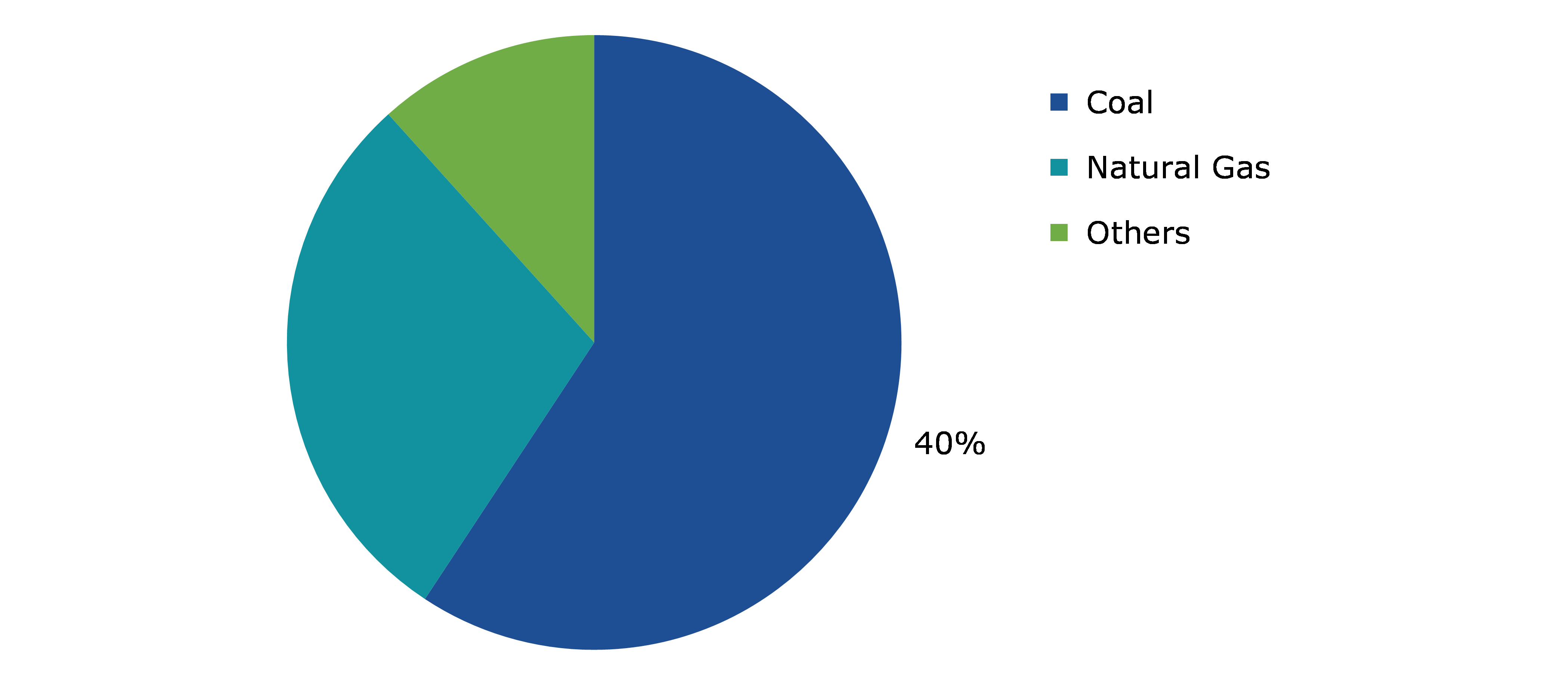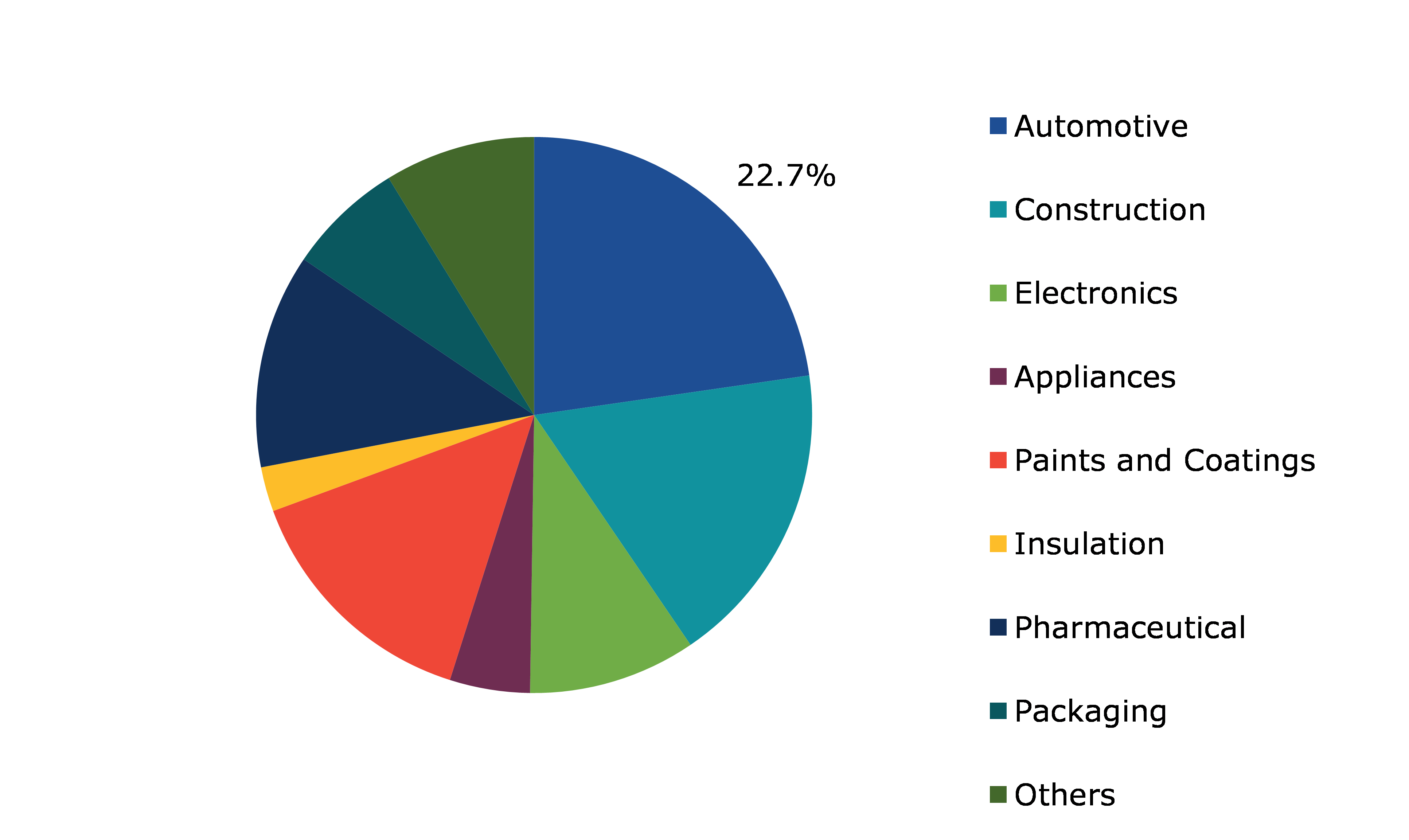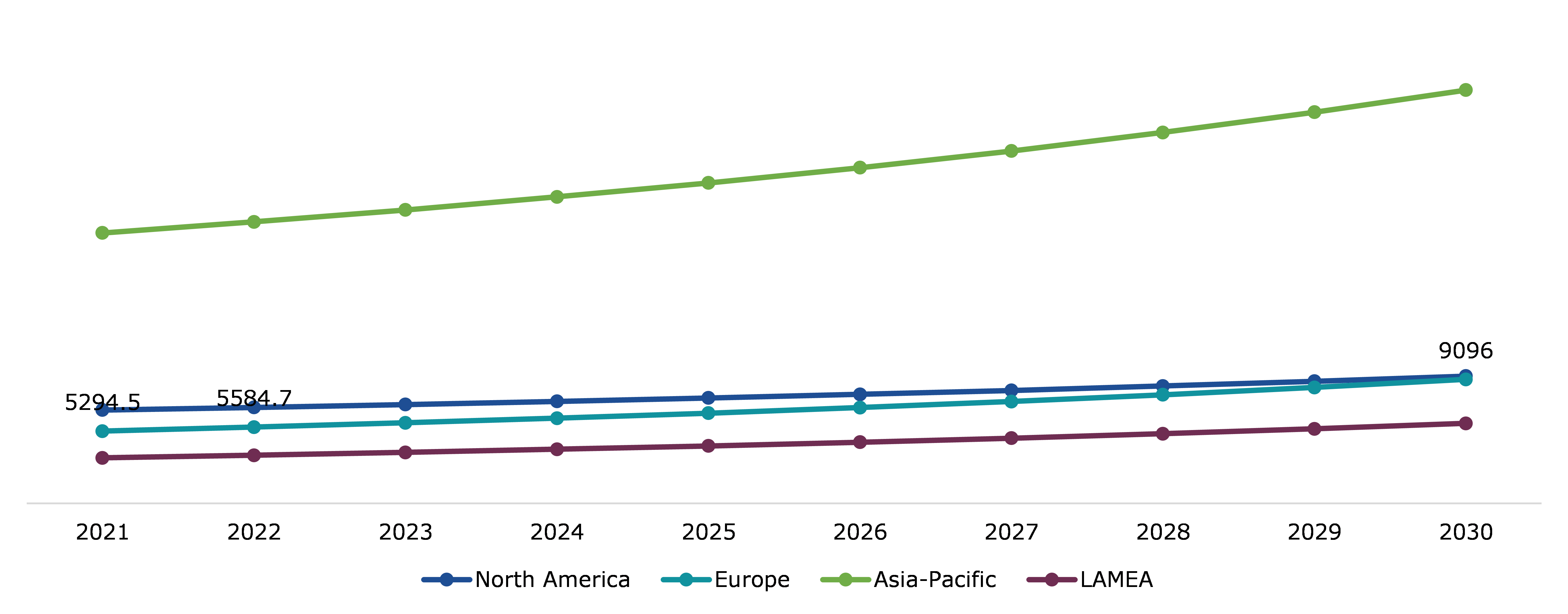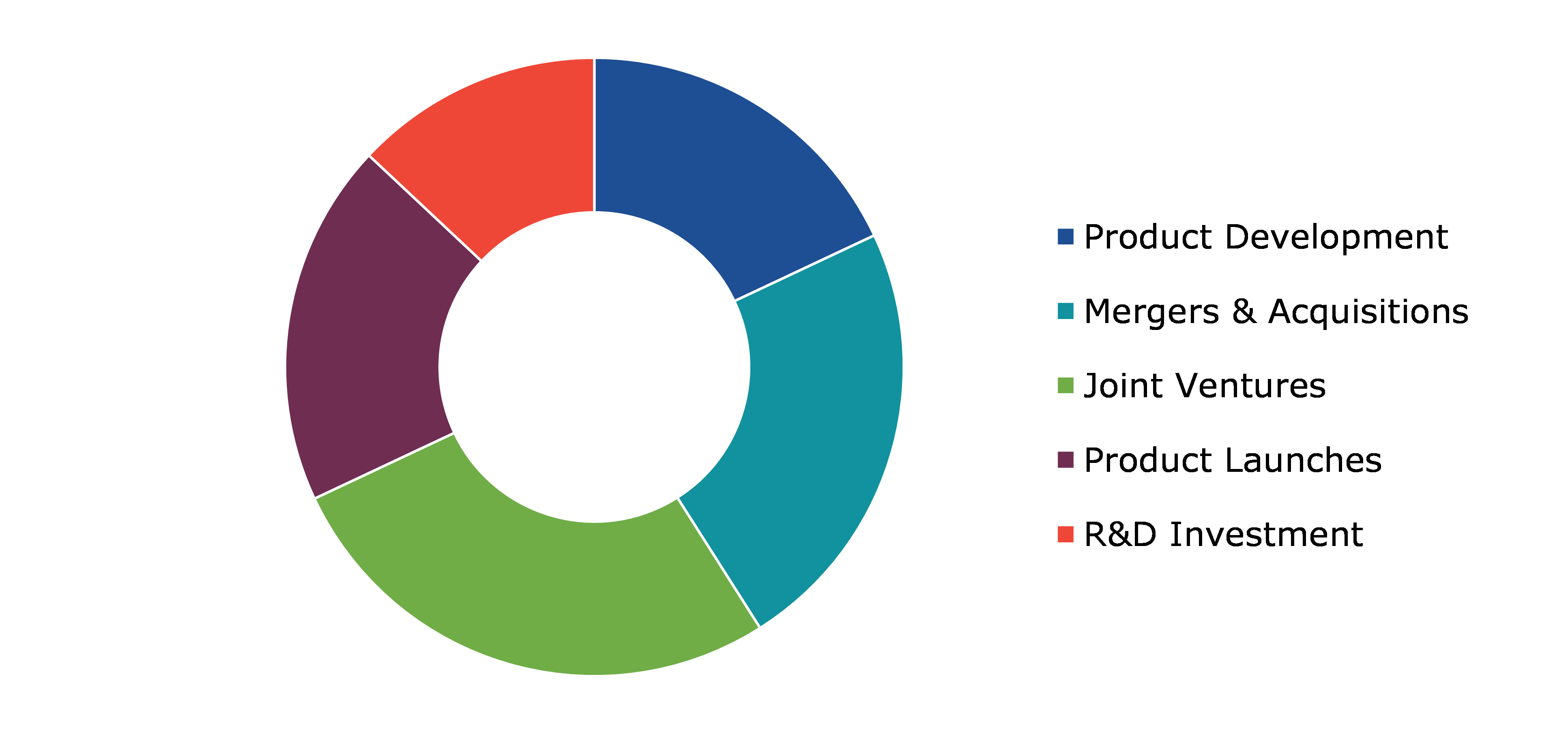Methanol Market Report
RA08500
Methanol Market by Feedstock (Coal, Natural Gas, and Others), End-use Industry (Automotive, Construction, Electronics, Appliances, Paints & Coatings, Insulation, Pharmaceutical, Packaging, and Others), and Regional Analysis (North America, Europe, Asia-Pacific, and LAMEA): Global Opportunity Analysis and Industry Forecast, 2022-2030
Global Methanol Market Analysis
The global methanol market size was $35,320.0 million in 2021 and is predicted to grow with a CAGR of 5.0%, by generating a revenue of $54,630.4 million by 2030.
Global Methanol Market Synopsis
Methanol market is gaining significant popularity as it acts as an alternative to conventional transportation fuels such as ethanol. Methanol has low production costs and lower risk of flammability due to which they are widely used compared to gasoline-based fuels. Also, methanol can meet the domestic fuel requirements as it can be produced from different feedstocks such as natural gas and coal. One of the major advantages of methanol is its ability to blend with gasoline that replaces the use of harmful octane enhancers. Thus, ability of methanol to blend with gasoline can enhance the performance of automobiles by lowering the risk of flammability. The growing application of methanol in the hydrogen fuel cells as it is an excellent hydrogen carrier fuel is a major growth driving factor. Hydrogen fuel cells are becoming extremely popular as it is a clean and efficient source for electricity generation. These factors are anticipated to boost the methanol industry growth in the upcoming years.
However, some of the disadvantages of methanol include lack of dedicated infrastructure. Also, methanol is highly flammable, corrosive, and toxic due to which its exposure can cause eye damage that can cause blindness by causing damage to the optic nerve. In addition, high exposure to this toxic fuel is known to cause damage to central nervous system that can be fatal.
The use of methanol as a marine fuel is anticipated to gain significant market share. This is because methanol is cost-effective fuel as well as it can meet the stringent emission regulations of the industry to avoid environmental hazards such as air pollution. The use of methanol in shipping sector lowers the emissions of hazardous sulphur oxides, nitrogen oxides, and other harmful particulate matter. Also, the cost required to convert existing vessels to run on methanol is cheaper compared to other fuel conversion alternatives such as gasoline.
According to regional analysis, the Asia-Pacific methanol market accounted for $19,849.8 million in 2021 and is predicted to grow with a CAGR of 4.9% in the projected timeframe. This is because in China, the use of methanol as a clean fuel in transportation is under large-scale development as the number of methanol-powered vehicles in China is increasing rapidly.
Methanol Overview
Methanol, also known as methyl alcohol or methyl hydrate is the simplest alcohol, which is light, colorless, flammable, volatile and has distinctive alcoholic odor. It has wide range of applications in industrial sector where methanol is used as an industrial fuel, solvent, and others. Also, it is largely used in paints & coatings, automotive, packaging pharmaceutical, electronics, and insulation industry.
COVID-19 Impact on Global Methanol Market
The COVID-19 pandemic has brought several uncertainties leading to severe economic losses as various businesses across the world were standstill. This has ultimately lowered the demand for methanol due to disruptions in supply chain, closure of manufacturing plants, as well as economic slowdown across several countries. In addition, the import-export restrictions were laid down on major methanol producing countries such as the U.S. and China. For instance, sanitization of goods being imported from China was imposed by several countries. In addition, the construction & automotive sector faced the highest impact in terms of sales and acquisition of new projects due to which the methanol demand reduced significantly. For instance, in construction industry, several construction projects were postponed or cancelled due to shortage of raw materials, labors, fear of contracting the COVID-19 virus among workers, as well as travel restrictions. Similarly, in the automotive sector, methanol is used in spark-ignition engines. However, disruptions in the exports of automotive parts from China as well as closure of automotive assembly and manufacturing units have hampered the methanol market share during the pandemic. However, in October 2021, the Indian government took new initiative to produce methanol from coal using coal-to-liquid technology. The first project under coal-to-liquid technology has been launched in West Bengal. Also, the second coal-to-liquid methanol generation project has been established at Sonapur, near Asansol, West Bengal. These initiatives are predicted to drive the methanol market size during the analysis timeframe.
Growing Application of Methanol in Industrial Sector to Drive the Market Growth
Methanol has immense application across day-to-day products. For instance, methanol is used in several chemical applications as a solvent. For instance, in feedstock, methanol is used for the production of several chemicals such as acetic acid and formaldehyde. Also, it is used in the manufacturing of foams, windshield washer fluids, plywood subfloors, and others. In addition, methanol can be blended with gasoline for the production of high-octane fuel. Also, this high-octane methanol fuel produces lower emissions compared to gasoline fuel thereby reducing the negative environmental impact. In China, methanol is largely used in industrial boilers, kilns, furnaces, and other thermal applications. Also, methanol is a vital component of biodiesel which is largely used renewable fuel.
To know more about global methanol market drivers, get in touch with our analysts here.
Growing Popularity of Ethanol and Bioethanol Over Methanol to Restrain the Market Growth
Ethanol is less chemically toxic and carries more energy per gallon compared to methanol which is 75% of energy of gasoline per gallon. Also, methanol is more corrosive compared to ethanol which is anticipated to restrain methanol market share in the upcoming years. In addition, the cost of raw materials required for the production of methanol such as capital costs, freight costs, the cost of coal & natural gas is high, which is anticipated to hamper the methanol market growth.
Use of Methanol as a Biodiesel and for Production of Olefins to Drive Excellent Opportunities
Methanol is widely used for the production of biodiesel. Biodiesel is a renewable fuel derived from animal fats or plant oils. The use of methanol in the production of biodiesel acts as a catalyst in the production process. Also, methanol is used in the manufacturing of plastic products for the production of light olefins which are the building blocks for plastic manufacturing. The production of olefins from methanol is known as methanol-to-olefins (MTO) process. Thus, innovative applications of methanol can be used to fuel marine vessels, boilers, cars, trucks, kilns, cookstoves, and others. Also, methanol is clean, sustainable fuel and its clean burning properties make it a net carbon-neutral fuel that leads to lower greenhouse emissions.
To know more about global methanol market opportunities, get in touch with our analysts here.
Global Methanol Market, by Feedstock
Based on feedstock, the market has been divided into coal, natural gas, and others. Among these, the natural gas sub-segment accounted for the highest market share in 2021 whereas the coal sub-segment is estimated to show the fastest growth during the forecast period.
Global Methanol Market Share, By Feedstock, 2021
Source: Research Dive Analysis
The natural gas sub-type is anticipated to have a dominant market share and generate a revenue of $23,522.9 million by 2030, growing from $14,951.2 million in 2021. The production of methanol from natural gas is a simple process that involves simple processes such as synthesis gas production, syngas conversion into crude methanol, and crude methanol distillation to achieve the desired purity. The methanol produced using this process is water soluble, clear liquid, and readily biodegradable. The use of methanol as a feedstock offers several advantages such as energy security owing to low dependence on gasoline-based fuel, lower production cost, and others. The use of natural gas as a feedstock is safe compared to gasoline-based fuels owing to low risk of flammability. In addition, the efficiency of methanol production from natural gas is as high as 50-60%and it depends on degree of waste heat recovery.
The coal sub-type is anticipated to show the fastest growth and shall generate a revenue of $13,582.8 million by 2030, increasing from $8,020.8 million in 2021. The lower prices of coal and presence of vast coal reserves have increased the demand for use of coal as a feedstock. Also, the use of coal can address the issues related to decline in fuel supplies, thereby reducing the carbon emissions. On September 10, 2021, Bharat Heavy Electricals Limited (BHEL), the India based largest power generation equipment manufacturer, successfully demonstrated the methanol production from coal. This methanol can be used as a motor fuel to power ship.
Global Methanol Market, by End-use Industry
Based on end-use industry, the market has been divided into automotive, construction, electronics, appliances, paints & coatings, insulation, pharmaceutical, packaging, and others. Among these, the automotive sub-segment accounted for highest revenue share in 2021.
Global Methanol Market Share, By End-use Industry, 2021
Source: Research Dive Analysis
The automotive sub-segment is anticipated to have a dominant market share and generate a revenue of $11,028.7 million by 2030, growing from $8,025.9 million in 2021. In automotive sector, methanol is widely used as a motor fuel owing to high octane content that boosts the vehicle efficiency and improves the power and acceleration. In addition, methanol as a fuel in automotive industry utilizes existing infrastructure, offers low price per calorie, and is a safer liquid fuel. The use of methanol in gas turbines lowers the harmful nitrous oxide emissions by almost 80%. Thus, the use of methanol is economically beneficial, low-cost fuel system, and complies with clean air law requirements. These factors are anticipated to boost the growth of automotive sub-segment during the analysis timeframe.
Global Methanol Market, Regional Insights
The methanol market was investigated across North America, Europe, Asia-Pacific, and LAMEA.
Global Methanol Market Size & Forecast, By Region, 2021-2030 (USD Million)
Source: Research Dive Analysis
The Market for Methanol in Asia-Pacific to be the Most Dominant
The Asia-Pacific methanol market accounted $19,849.8 million in 2021 and is projected to grow with a CAGR of 4.9%. The demand for methanol in the Asia-Pacific region is driven by its use as a low emission alternative fuel that helps in achieving low carbon mobility. At present, in India, the methanol production capacity is 2 MT per annum. However, as per NITI Aayog, the Indian government agency, the use of biomass, high ash coal, and stranded gas can increase the methanol production to 20 MT per annum by 2025. This is because India generates 500 million tonnes of biomass every year, has 125 billion tonnes of coal reserves, with huge quantity of stranded and flared gas. In addition, the NITI Aayog has planned to substitute at least 10% of crude oil imports with methanol by 2030. In addition, the Indian government is working on the use of Di Methyl Ether (DME) and methanol in transportation sector for rail, marine, road, and defense sector. Also, use of methanol in mobile towers, power generation, industrial boilers, diesel gensets, and other applications is gaining significant popularity.
Competitive Scenario in the Global Methanol Market
Investment and agreement are common strategies followed by major market players. For instance, in March 2022, Proman, the leading petrochemicals company, entered into cooperation agreement with Maersk, the Denmark-based shipping company for the development of green methanol supply solutions to produce methanol-fueled container vessels.
Source: Research Dive Analysis
Some of the leading methanol market players are Celanese Corporation, BASF SE, Methanex Corporation, SABIC, Petroliam Nasional Berhad (PETRONAS), Mitsubishi Gas Chemical Company, Inc., Valero, Mitsui & Co., Ltd., Zagros Petrochemical Co., and Methanol Holdings (Trinidad) Limited.
| Aspect | Particulars |
| Historical Market Estimations | 2019-2020 |
| Base Year for Market Estimation | 2021 |
| Forecast Timeline for Market Projection | 2022-2030 |
| Geographical Scope | North America, Europe, Asia-Pacific, LAMEA |
| Segmentation by Feedstock |
|
| Segmentation by End-use Industry |
|
| Key Companies Profiled |
|
Q1. What is the size of the global methanol market?
A. The size of the global methanol market was over $35,320.0 million in 2021 and is projected to reach $54,630.4 million by 2030.
Q2. Which are the major companies in the methanol market?
A. Celanese Corporation, Methanex Corporation, and BASF SE are some of the key players in the global methanol market.
Q3. Which region, among others, possesses greater investment opportunities in the near future?
A. The Asia-Pacific region possesses great investment opportunities for investors to witness the most promising growth in the future.
Q4. What will be the growth rate of the Asia-Pacific methanol market?
A. Asia Pacific methanol market is anticipated to grow at 4.9% CAGR during the forecast period.
Q5. What are the strategies opted by the leading players in this market?
A. Agreement and investment are the two key strategies opted by the operating companies in this market.
Q6. Which companies are investing more on R&D practices?
A. Petroliam Nasional Berhad (PETRONAS), SABIC, and Mitsubishi Gas Chemical Company, Inc. are the companies investing more on R&D activities for developing new products and technologies.
1.Research Methodology
1.1.Desk Research
1.2.Real time insights and validation
1.3.Forecast model
1.4.Assumptions and forecast parameters
1.5.Market size estimation
1.5.1.Top-down approach
1.5.2.Bottom-up approach
2.Report Scope
2.1.Market definition
2.2.Key objectives of the study
2.3.Report overview
2.4.Market segmentation
2.5.Overview of the impact of COVID-19 on Global methanol market
3.Executive Summary
4.Market Overview
4.1.Introduction
4.2.Growth impact forces
4.2.1.Drivers
4.2.2.Restraints
4.2.3.Opportunities
4.3.Market value chain analysis
4.3.1.List of raw material suppliers
4.3.2.List of manufacturers
4.3.3.List of distributors
4.4.Innovation & sustainability matrices
4.4.1.Technology matrix
4.4.2.Regulatory matrix
4.5.Porter’s five forces analysis
4.5.1.Bargaining power of suppliers
4.5.2.Bargaining power of consumers
4.5.3.Threat of substitutes
4.5.4.Threat of new entrants
4.5.5.Competitive rivalry intensity
4.6.PESTLE analysis
4.6.1.Political
4.6.2.Economical
4.6.3.Social
4.6.4.Technological
4.6.5.Environmental
4.7.Impact of COVID-19 on methanol market
4.7.1.Pre-covid market scenario
4.7.2.Post-covid market scenario
5.Methanol Market Analysis, by Feedstock
5.1.Overview
5.2.Coal
5.2.1.Definition, key trends, growth factors, and opportunities
5.2.2.Market size analysis, by region
5.2.3.Market share analysis, by country
5.3.Natural Gas
5.3.1.Definition, key trends, growth factors, and opportunities
5.3.2.Market size analysis, by region
5.3.3.Market share analysis, by country
5.4.Others
5.4.1.Definition, key trends, growth factors, and opportunities
5.4.2.Market size analysis, by region
5.4.3.Market share analysis, by country
5.5.Research Dive Exclusive Insights
5.5.1.Market attractiveness
5.5.2.Competition heatmap
6.Methanol Market Analysis, by End-use Industry
6.1.Automotive
6.1.1.Definition, key trends, growth factors, and opportunities
6.1.2.Market size analysis, by region
6.1.3.Market share analysis, by country
6.2.Construction
6.2.1.Definition, key trends, growth factors, and opportunities
6.2.2.Market size analysis, by region
6.2.3.Market share analysis, by country
6.3.Electronics
6.3.1.Definition, key trends, growth factors, and opportunities
6.3.2.Market size analysis, by region
6.3.3.Market share analysis, by country
6.4.Appliances
6.4.1.Definition, key trends, growth factors, and opportunities
6.4.2.Market size analysis, by region
6.4.3.Market share analysis, by country
6.5.Paints and Coatings
6.5.1.Definition, key trends, growth factors, and opportunities
6.5.2.Market size analysis, by region
6.5.3.Market share analysis, by country
6.6.Insulation
6.6.1.Definition, key trends, growth factors, and opportunities
6.6.2.Market size analysis, by region
6.6.3.Market share analysis, by country
6.7.Pharmaceutical
6.7.1.Definition, key trends, growth factors, and opportunities
6.7.2.Market size analysis, by region
6.7.3.Market share analysis, by country
6.8.Packaging
6.8.1.Definition, key trends, growth factors, and opportunities
6.8.2.Market size analysis, by region
6.8.3.Market share analysis, by country
6.9.Others
6.9.1.Definition, key trends, growth factors, and opportunities
6.9.2.Market size analysis, by region
6.9.3.Market share analysis, by country
6.10.Research Dive Exclusive Insights
6.10.1.Market attractiveness
6.10.2.Competition heatmap
7.Methanol Market, by Region
7.1.North America
7.1.1.U.S.
7.1.1.1.Market size analysis, by Feedstock
7.1.1.2.Market size analysis, by End-use Industry
7.1.2.Canada
7.1.2.1.Market size analysis, by Feedstock
7.1.2.2.Market size analysis, by End-use Industry
7.1.3.Mexico
7.1.3.1.Market size analysis, by Feedstock
7.1.3.2.Market size analysis, by End-use Industry
7.1.4.Research Dive Exclusive Insights
7.1.4.1.Market attractiveness
7.1.4.2.Competition heatmap
7.2.Europe
7.2.1.Germany
7.2.1.1.Market size analysis, by Feedstock
7.2.1.2.Market size analysis, by End-use Industry
7.2.2.UK
7.2.2.1.Market size analysis, by Feedstock
7.2.2.2.Market size analysis, by End-use Industry
7.2.3.France
7.2.3.1.Market size analysis, by Feedstock
7.2.3.2.Market size analysis, by End-use Industry
7.2.4.Spain
7.2.4.1.Market size analysis, by Feedstock
7.2.4.2.Market size analysis, by End-use Industry
7.2.5.Italy
7.2.5.1.Market size analysis, by Feedstock
7.2.5.2.Market size analysis, by End-use Industry
7.2.6.Rest of Europe
7.2.6.1.Market size analysis, by Feedstock
7.2.6.2.Market size analysis, by End-use Industry
7.2.7.Research Dive Exclusive Insights
7.2.7.1.Market attractiveness
7.2.7.2.Competition heatmap
7.3.Asia Pacific
7.3.1.China
7.3.1.1.Market size analysis, by Feedstock
7.3.1.2.Market size analysis, by End-use Industry
7.3.2.Japan
7.3.2.1.Market size analysis, by Feedstock
7.3.2.2.Market size analysis, by End-use Industry
7.3.3.India
7.3.3.1.Market size analysis, by Feedstock
7.3.3.2.Market size analysis, by End-use Industry
7.3.4.Australia
7.3.4.1.Market size analysis, by Feedstock
7.3.4.2.Market size analysis, by End-use Industry
7.3.5.South Korea
7.3.5.1.Market size analysis, by Feedstock
7.3.5.2.Market size analysis, by End-use Industry
7.3.6.Rest of Asia Pacific
7.3.6.1.Market size analysis, by Feedstock
7.3.6.2.Market size analysis, by End-use Industry
7.3.7.Research Dive Exclusive Insights
7.3.7.1.Market attractiveness
7.3.7.2.Competition heatmap
7.4.LAMEA
7.4.1.Brazil
7.4.1.1.Market size analysis, by Feedstock
7.4.1.2.Market size analysis, by End-use Industry
7.4.2.Saudi Arabia
7.4.2.1.Market size analysis, by Feedstock
7.4.2.2.Market size analysis, by End-use Industry
7.4.3.UAE
7.4.3.1.Market size analysis, by Feedstock
7.4.3.2.Market size analysis, by End-use Industry
7.4.4.South Africa
7.4.4.1.Market size analysis, by Feedstock
7.4.4.2.Market size analysis, by End-use Industry
7.4.5.Rest of LAMEA
7.4.5.1.Market size analysis, by Feedstock
7.4.5.2.Market size analysis, by End-use Industry
7.4.6.Research Dive Exclusive Insights
7.4.6.1.Market attractiveness
7.4.6.2.Competition heatmap
8.Competitive Landscape
8.1.Top winning strategies, 2021
8.1.1.By strategy
8.1.2.By year
8.2.Strategic overview
8.3.Market share analysis, 2021
9.Company Profiles
9.1.Celanese Corporation
9.1.1.Overview
9.1.2.Business segments
9.1.3.Product portfolio
9.1.4.Financial performance
9.1.5.Recent developments
9.1.6.SWOT analysis
9.2.BASF SE
9.2.1.Overview
9.2.2.Business segments
9.2.3.Product portfolio
9.2.4.Financial performance
9.2.5.Recent developments
9.2.6.SWOT analysis
9.3.Methanex Corporation
9.3.1.Overview
9.3.2.Business segments
9.3.3.Product portfolio
9.3.4.Financial performance
9.3.5.Recent developments
9.3.6.SWOT analysis
9.4.SABIC
9.4.1.Overview
9.4.2.Business segments
9.4.3.Product portfolio
9.4.4.Financial performance
9.4.5.Recent developments
9.4.6.SWOT analysis
9.5.Petroliam Nasional Berhad (PETRONAS)
9.5.1.Overview
9.5.2.Business segments
9.5.3.Product portfolio
9.5.4.Financial performance
9.5.5.Recent developments
9.5.6.SWOT analysis
9.6.Mitsubishi Gas Chemical Company, Inc.
9.6.1.Overview
9.6.2.Business segments
9.6.3.Product portfolio
9.6.4.Financial performance
9.6.5.Recent developments
9.6.6.SWOT analysis
9.7.Valero Mitsui & Co., Ltd.
9.7.1.Overview
9.7.2.Business segments
9.7.3.Product portfolio
9.7.4.Financial performance
9.7.5.Recent developments
9.7.6.SWOT analysis
9.8.Mitsui & Co., Ltd.
9.8.1.Overview
9.8.2.Business segments
9.8.3.Product portfolio
9.8.4.Financial performance
9.8.5.Recent developments
9.8.6.SWOT analysis
9.9.Zagros Petrochemical Co.
9.9.1.Overview
9.9.2.Business segments
9.9.3.Product portfolio
9.9.4.Financial performance
9.9.5.Recent developments
9.9.6.SWOT analysis
9.10.Methanol Holdings (Trinidad) Limited
9.10.1.Overview
9.10.2.Business segments
9.10.3.Product portfolio
9.10.4.Financial performance
9.10.5.Recent developments
9.10.6.SWOT analysis
10.Appendix
10.1.Parent & peer market analysis
10.2.Premium insights from industry experts
10.3.Related reports
Methanol is referred to as methyl alcohol which is used extensively in everyday products and industrial applications. It is a highly versatile chemical with efficiency of an energy carrier. The demand of methanol has been increased in recent years as a fuel for manufacturing units. Methanol is also being used in different parts of the world as a resource of clean energy.
Impact Analysis of COVID-19 on the Market
The emergence of COVID-19 pandemic affected the industries small and big across the world. The global economy has experienced slowdown and hence the loss of revenue in almost all the manufacturing units. The global methanol market has also been affected in negative way during the pandemic. Moreover, restrictions on import-export and supply chain have impacted the major countries including China and USA which produce methanol. However, the leading players of the market are developing many strategies to sustain the methanol market growth in the post pandemic period.
Recent Developments in the Methanol Market
According to a report published by Research Dive, the leading players of the global methanol market include Celanese Corporation, Methanex Corporation, BASF SE, SABIC, Mitsubishi Gas Chemical Company, Inc., Petroliam Nasional Berhad (PETRONAS), Valero, Zagros Petrochemical Co., Mitsui & Co., Ltd., and Methanol Holdings (Trinidad) Limited.
These industry players are investing a lot of efforts on the research and development of smart and unique strategies to sustain the growth of the market. These strategies include product launches, mergers and acquisitions, collaborations, partnerships, and refurbishing of existing technology. Some of the recent developments of the market are as follows:
- In April 2019, Celanese Corporation, a global chemical and specialty materials company, expanded the production capacity at its Clear Lake acetyl intermediates manufacturing facility located in Texas, USA. The production will be increased to around 1.7 million tonnes per annum, a surge of 125% from the original capacity. The company has been granted approvals from the board of directors of Fairway Methanol LLC for a second phase expansion.
- In April 2020, Celanese Corporation, a global chemical and specialty materials company, announced about the completion of the acquisition of redispersible polymer powders business of Nouryon offered under the Elotex® brand. Celanese is looking forward to integrate the Elotex® product portfolio and production facilities into its global vinyl acetate ethylene (VAE) emulsions business to further contribute to the global product demand.
- In April 2021, Origin Materials, Inc., the world leader in carbon negative materials, entered into a partnership with Mitsubishi Gas Chemical, Inc., a global leader in basic and fine chemicals and advanced materials. This partnership is expected to mechanize and manufacture advanced chemicals and materials built on the Origin Materials technology platform.
- In August 2021, The National Gas Company of Trinidad and Tobago Limited (NGC) inked a Consolidated Gas Supply Contract (CGSC) with Methanol Holdings (Trinidad) Limited (MHTL), part of the Proman family of companies which is also the largest methanol producer in the world. The agreement is supposed to upkeep operations at the MHTL Methanol Complex, which includes one of the world’s most competent producers of low carbon methanol-- the mega-methanol M5 plant.
Forecast Analysis of Global Market
The global methanol market is projected to witness an exponential growth over the forecast period, owing to the wide usage of methanol for the production of biodiesel, olefins, and the manufacturing of plastic products. Conversely, the rising popularity of ethanol and bioethanol over methanol and the high costs associated with the raw materials used for the production of methanol are expected to hamper the market growth in the projected timeframe.
The increasing application of methanol in industrial sector and the rising popularity of methanol as an alternative to conventional transportation fuels are the significant factors and methanol market trends estimated to bolster the growth of the global market in the coming future. According to a latest report published by Research Dive, the global methanol market is expected to garner $54,630.4 million during the forecast period (2022-2030). Geographically, the Asia-Pacific region of the methanol market is estimated to be most dominant by 2030, owing to the rising demand for methanol in countries like India and other for using as a low emission alternative fuel and achieving low carbon mobility in the region. Presently, the methanol production capacity in India is 2 MT per annum.
Personalize this research
- Triangulate with your own data
- Request your format and definition
- Get a deeper dive on a specific application, geography, customer or competitor
- + 1-888-961-4454 Toll - Free
- support@researchdive.com






